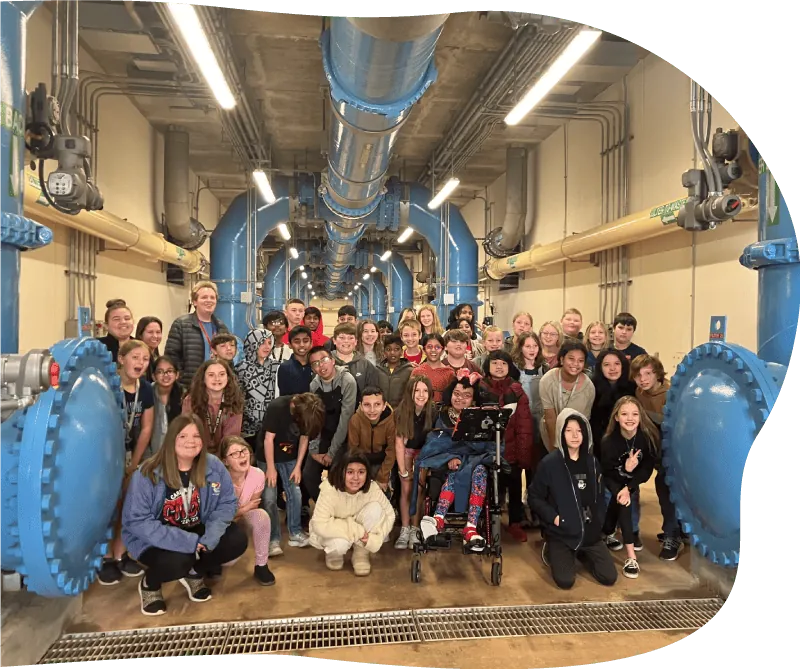Drinking Water Treatment Tour
How does Beaver Water District (BWD) clean water from Beaver Lake to make it safe for drinking and usable? This is one of many questions answered during the Drinking Water Treatment Tour. Students will learn about the water supply of Northwest Arkansas (NWA), the four customer cities of BWD (and surrounding communities) and gain an understanding of the process for providing clean, safe drinking water to the public, businesses, and industries right here in NWA.
Water Fun Facts Scavenger Hunt
Participants join Randy the frog and Castor the beaver in a fun and educational scavenger hunt for water facts! Exploring outside the BWD's education building, students search for signs featuring Randy and/or Castor with interesting water facts and fill in the blanks on their scavenger hunt sheets. BWD educators then facilitate discussions on the importance of water conservation as they go through students' answers as a group. This lesson allows students to stretch their legs and leaves them thinking about how water usage impacts all of us.
Low Impact Development Scavenger Hunt
Students will be introduced to "Smart Growth" construction, including Leadership in Energy and Environmental Design (LEED) and Low Impact Development (LID) methods and goals. Student teams will explore the various aspects of LEED and LID purposes and practices during a field trip at Beaver Water District. The field trip will raise students' awareness pertaining to activities and behaviors that will protect the Beaver Lake and the Illinois River watershed, and the importance of being involved in local water quality.
A Water Droplet's Journey Through the Urban Water Cycle
Based off Project WET's Incredible Journey, students act as a water droplet traveling through infrastructure during human use. In this simulation, participants are sent from the source water (Beaver Lake) to visit each part of the urban water cycle thereafter. Students learn how water gets to the faucets and where it goes once down the drain. The discussion involves key terms such as watershed, stormwater, and inter-basin transfer.
A Water Droplet's Journey
Based off Project WET's curriculum, this lesson describes the movement of water within nature's water cycle and identifies key vocabulary terms related to water. The hands-on activity allows students to imagine themselves as a water droplet traveling through the water cycle. They create a bracelet/key chain with different colored beads representing the places of the journey. After the activity, students discuss what conditions and processes were necessary for water to move to each place.
History of BWD and Beaver Dam
Many of us today take water for granted, but the leaders who formed Beaver Dam Association and Beaver Water District understood that clean drinking water is precious and ensures the continued health and economic growth of a region. Let us tell the local history of how these leaders pulled together to make safe, economical drinking water for all a reality in NWA, and how we continue to plan for the growth of NWA.
Water Quality Testing
Testing source water and recording data is the first step of source water protection-the first step in the drinking water treatment process. Using La Mote water quality testing kits, students will test levels for nitrate, phosphate, pH, alkalinity, and dissolved oxygen. After collecting data, students will communicate their findings with the class.
Watershed Demonstration
Students will gain knowledge and enhance their skills in identifying urban and agricultural point and non-point source pollution using a watershed model. Students take turns demonstrating how pollution can occur throughout the watershed. This lesson answers questions such as: Where does pollution come from? How does pollution get into waterways? What are best management practices to lessen the burden of point and nonpoint source pollutants? Why is source water protection important? Human influence on the health of waterways is emphasized here.
Urban Water Cycle Tour
In collaboration with partners Hobbs State Park-Conservation Area, Illinois River Watershed Partnership, Army Corps of Engineers, and our customer cities, students experience first-hand how water moves through human use. Immersed in water use and water careers, this field trip is focused on the Urban Water Cycle from the source, to drinking water, to wastewater, and then back to the source. Stopping at three locations throughout the day, participants learn where their water comes from, how it's made safe to drink, how it gets to and from homes/businesses, and how it is made safe to put back into the waterways. This field trip experience is sure to not disappoint!

